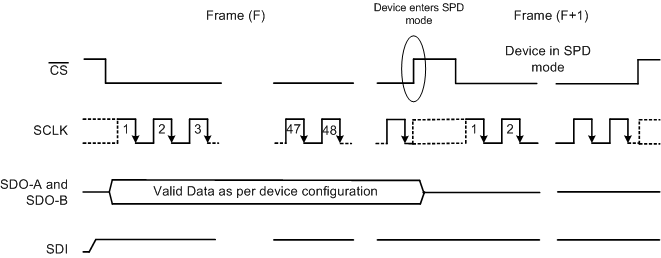SBAS931B January 2019 – July 2022 ADS8353-Q1
PRODUCTION DATA
- 1Features
- 2Applications
- 3Description
- 4Revision History
- 5Pin Configuration and Functions
- 6Specifications
- 7Detailed Description
- 8Application and Implementation
- 9Device and Documentation Support
Package Options
Mechanical Data (Package|Pins)
- PW|16
Thermal pad, mechanical data (Package|Pins)
Orderable Information
7.5.4.2 Software Power-Down (SPD) Mode
In software power-down (SPD) mode, all internal circuits (including the internal references) are powered down. However, the contents of the REFDAC_A and REFDAC_B registers are retained.
As shown in Figure 7-10, to enter SPD mode, the device must be selected (by bringing CS low) and SDI must be kept high for a minimum of 48 SCLK cycles during frame (F). The device goes to SPD on the CS rising edge following frame (F). While in SPD mode, SDO_A and SDO_B go to 3-state irrespective of the status of the CS signal.
To remain in SPD mode, SDI must remain high in all subsequent frames.
 Figure 7-10 Enter SPD Mode
Figure 7-10 Enter SPD ModeAs shown in Figure 7-11, to exit SPD mode, the device must be selected (by bringing CS low) and SDI must be kept low for a minimum of 48 SCLK cycles during frame (F+3). The device starts powering-up on a CS rising edge following frame (F+3). After frame (F+3), a delay of tPU_SPD must elapse before programming the configuration register.
A valid write operation in frame (F+4) sets the device configuration for frame (F+5). Frame (F+4) must have at least 48 SCLK falling edges. Discard the output data in frame (F+4).
See the Section 6.6 table for timing specifications for this operating mode.
